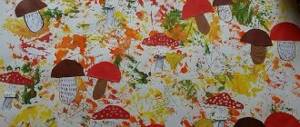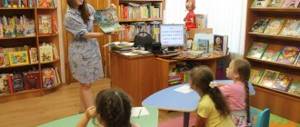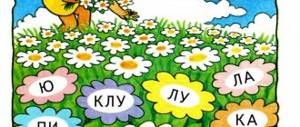project “My Favorite Fairy Tale” project on fiction (preparatory group)
Project “My Favorite Fairy Tale”
Project type: educational, creative
Participants: older children, teachers, parents.
Implementation period: short-term – 2 weeks.
Project goal and objectives
Goal: to create optimal conditions for the development of speech in preschool children through theatrical activities
Tasks:
- Create conditions for the development of children's creative activity and the gradual development of various types of creativity by children.
- Enrich children's vocabulary, improve dialogical speech, develop the ability to use a variety of language means in speech.
Contribute to the formation of communication abilities.
Relevance
One of the modern innovative teaching methods is project activity - a technology that teaches children to express their individuality in creativity, makes it possible to interest children, and make the learning process personally significant.
The relevance of the project lies in the fact that it combines means and methods for developing the child’s creative and speech abilities. It can be argued that theatrical activity is a source of development of feelings, deep experiences and discoveries of a child, and introduces him to spiritual values. In the game, the child’s vocabulary is imperceptibly activated, the sound culture of speech, its intonation structure, dialogical speech, and its grammatical structure are improved.
Formulation of the problem
In recent years, there has been a sharp decline in the level of speech development of preschool children. Such deviations, one way or another, affect the subsequent development and education of the child. One of the reasons for the decline in the level of speech development is the passivity and ignorance of parents in matters of children's speech development. The participation of parents in the speech development of the child plays a colossal role. That is why parents take an active part in the project.
Theatrical play, available from a very early age, serves as a stimulus for a child’s creative activity. The need to systematize it in a single pedagogical process is obvious. Children’s enthusiasm for theatrical play, their inner comfort, relaxedness, easy, non-authoritarian communication between an adult and a child, the “I can’t do it” complex disappears almost immediately - all this surprises and attracts.
Preparatory stage:
- Studying literature on the topic
- Explore best practices
- Consultation for parents
- Clarification of the formulation of the problem, topic, goals and objectives
- Selection of visual teaching aids, demonstration material
- Decorating a book corner
Main stage:
- Looking at illustrations of Russian folk tales
- Reading and telling Russian folk tales, conversation based on the read tale
- Conducting board-printed, didactic, word games
- Drawing on the theme “My favorite fairy-tale hero”
- Game educational situation “Kolobok’s Journey”
- Guessing riddles based on the fairy tale "Kolobok"
- Application "Kolobok"
- Exhibition of crafts made from waste materials “Our beloved Kolobok”
- Creation of a card index of Russian folk tales in accordance with age
- Quiz on fairy tales “Guess the fairy tale”
The final stage:
- Presentation of the musical fairy tale “Kolobok”
- Decoration of the tabletop theater "Kolobok"
Expected results of the project:
- Development of creative activity of children, development of various types of creativity by preschool children.
- Enriching children's vocabulary, improving dialogical speech, using a variety of language means in speech.
- Formation of communication abilities.
Prospects for further use
- The layout of this project can be implemented based on any literary work chosen by the children.
Application
Game educational situation “Kolobok’s Journey”
- Program content:
- To develop children's spoken language, improve gross and fine motor skills using different materials, and cultivate interest in Russian folk tales.
- Preliminary work:
- - reading fairy tales “Spikelet”, “Three Bears”, “Kolobok”.
- -playing on flannelgraph.
- -table theater games.
- Material:
- Flannelograph, characters from the fairy tale “Kolobok”, “The Three Bears”, tabletop theater “Kolobok”, magic bag, balloons for each child.
- Progress:
- Children, accompanied by music, enter the group along the path and stand in a semicircle.
- Educator:
- We'll walk along the path
- Let's go straight into a fairy tale.
- One two three four five-
- We will play a fairy tale.
- Children, do you like to listen to fairy tales? I also really love fairy tales, can you help me tell them? We are now going to play the game “Fairy Tales with Holes.” I will read a fairy tale, and if I forget something, you will tell me.
- Who loved to play and sing?
- Two mice Spin... and (Turn).
- Who woke up the mice in the morning?
- Who went to the mill... (went)
- Grind a bag of flour?
- This is Petya... (Cockerel)
- He baked a lot of pies
- And he asked his friends sternly:
- “What were you doing little mice?
- From dawn to dusk)?
- Now sit down at the table,
- You raise your voice.
- No! Work hard first
- And read...("Spikelet").
- The teacher and the children approach the next fairy tale.
- Cups three and three beds
- There are also three chairs, look
- And the residents here, in fact
- Lives for exactly three.
- As you will see, it is immediately clear:
- Going to visit them...(dangerous)
- Run away quickly, little sister,
- Fly out of the window like..(a bird)
- She ran away. Well done!
- So the whole fairy tale is over!
- Fedya reads syllable by syllable:
- This is a fairy tale: "The Three Bears".
- The teacher approaches the table where the characters from the tabletop theater “Kolobok” are displayed.
- It was baked from flour,
- It was mixed with sour cream,
- He was chilling at the window
- Along the path...(rolled away)
- He was cheerful, he was brave,
- And on the way he sang a song.
- Who is this? "Kolobok"
- Guys! What song did he sing?
- Finger game "Kolobok".
- Me, Kolobok, Kolobok! (rolls an imaginary bun in their hands)
- Scraped along the bottom of the barrel (scrape the left hand with the right palm)
- Sweep around the barn (simulate sweeping the floor)
- Meshen on sour cream (circular movements with the right hand).
- Sat into the stove (show both arms extended forward)
- It’s cold on the window (show the window with your hands)
- I left my grandmother (they move the middle and index fingers of the right hand over the palm of the left)
- I left my grandfather.
- Where do you think the bun rolled along the path? (children's answers)
- Let's remember who the bun met in the forest. (Children sit at tables on which there are cards with images of a hare, wolf, bear, fox and separately a bun).
- I completely forgot, who did the bun meet first?
- Place your bun next to the hare. Then who did he meet? (wolf).
- What did the wolf say to him? (“Kolobok, Kolobok! I’ll eat you”). The bear met the kolobok (children place the kolobok next to the bear) and said to him in a thin voice: “Kolobok, kolobok! I will eat you!" Or maybe I messed something up, help me (the bear said in a thick, rough voice).
- But our little bun is not simple; after meeting the fox, he ran away and rolled on.
- The children have a story panel on their tables. On our next card there is a path drawn, let's take a ride along the path together with the kolobok. We hold the bun with our right hand. The bun rolls and rolls, and a “hedgehog” meets it. The bun looked at the hedgehog and was surprised. How surprised the bun was! Show how surprised the bun is. (Children show surprise).
- Guys, a problem happened to our hedgehog - he lost his needles, let's help him collect them, make them from matchsticks. (Children lay out thorns for the hedgehog from matches).
- What wonderful hedgehogs we have! The bun decided to admire the hedgehog, but our bun is small, and the hedgehog is big. Let's invite the bun to look at the hedgehog from the stump. The bun rolled up to the stump, climbed onto the stump, and looked at the hedgehog. The bun really liked the hedgehog and he smiled. I suggest our little bun draw a smile. What color pencil will we need for this, do you think? (red).
- What kind of bun did you get? (joyful, cheerful). Now let’s show the bun how we can rejoice.
- Fizminutka
- They stomped their feet (stomped their feet)
- Hands clapping (hands clapping)
- Hee hee hee (arms to the sides)
- Ha ha ha (hands up)
- What a beauty! (clap)
- The children sit at the tables.
- The bun said goodbye to the hedgehog and rolled on, looked around and saw strange trees around him that looked like his friend the hedgehog. What trees do you think he saw? (ate).
- Yes, spruce trees also have needles. Well done! Let's make a spruce tree for each of your koloboks; I suggest using yellow triangles for this. (Children correct the teacher; green triangles are needed).
- I am very glad that you are attentive to me! Our children are just great, they made an entire spruce forest!
- Guys, together we composed a continuation of the fairy tale “Kolobok”. Did you like her?
- Look, we also have a spruce tree growing in our group, let’s go up to it. And what's under the spruce tree? Children find a magic bag. The teacher pours out multi-colored balls from the bag. Look, they all look like who?
- (Koloboka). I suggest you play with them.







